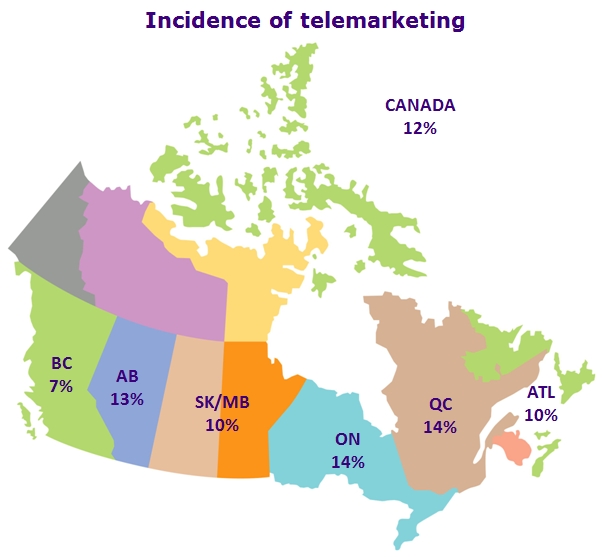
POR number: POR 039-15
Contract number: 82082-160275/001/CY
Original contract date: 2016-02-09
Submission date: 03/2016
Prepared for:
Canadian Radio-television and Telecommunications Commission
For more information on this report.
communications@crtc.gc.ca
Ce rapport est aussi disponible en français.
Prepared by:
Environics Research Group
PA 8828
The mandate of the Canadian Radio-television and Telecommunications Commission (CRTC) includes the responsibility to protect Canadians from unsolicited communications, including telemarketing. The protection of consumers against specific types of unwanted calls is governed by the Unsolicited Telecommunications Rules (UTRs), including the National Do Not Call List (DNCL) Rules. While the CRTC has some qualitative and quantitative data that speaks to the effectiveness of the DNCL, it identified the need for data specific to Canadian businesses for whom the UTRs apply.
Thus, a survey of Canadian businesses was conducted to obtain a clear picture of the scope of telemarketing activity in Canada, their awareness of the UTRs, their compliance activities, barriers they may face in achieving compliance, and additional tools they may need to improve compliance.
A telephone survey was conducted with a representative sample of 1,202 Canadian businesses, drawn from published lists, between February 23 and March 15, 2016. The sample was stratified by region and business size (number of employees). The margin of error for a sample of 1,202 is +/- 2.8 percentage points, in 19 out of 20 samples. The margin of error is greater for results pertaining to subgroups of this population (such as telemarketers).
A more detailed description of the methodology is presented at the back of the report, along with a copy of the questionnaire (see Appendix).
The cost of this research was $46,258.80 (GST included).
Incidence and profile of telemarketers
Telemarketing rules
Information needs
Non-telemarketers
I hereby certify as a Senior Officer of Environics Research Group that the deliverables fully comply with the Government of Canada political neutrality requirements outlined in the Communications Policy of the Government of Canada and Procedures for Planning and Contracting Public Opinion Research. Specifically, the deliverables do not contain any reference to electoral voting intentions, political party preferences, standings with the electorate, or ratings of the performance of a political party or its leader.
Sarah Roberton
Senior Research Associate, Public Affairs
Environics Research Group
sarah.roberton@environics.ca
(613) 230-5089
Supplier name: Environics Research Group
POR Registration Number: POR 039-15
PWGSC contract number: 82082-160275/001/CY
Contract award date: 2016-02-09
For more information, contact the CRTC at communications@crtc.gc.ca
The mandate of the Canadian Radio-television and Telecommunications Commission (CRTC) includes the responsibility to protect Canadians from unsolicited communications, including telemarketing.
The protection of consumers against specific types of unwanted calls is governed by the Unsolicited Telecommunications Rules (UTRs), comprising of three main parts: 1) the National Do Not Call List (DNCL) Rules, 2) the Telemarketing Rules, and 3) the Automatic Dialing-Announcing Device (ADAD) Rules.
The UTRs are applicable to thousands of Canadian businesses that use the telephone for the purpose of commercial telecommunications to Canadians, whether for themselves or on behalf of a third party. The CRTC delivers its mandate under the UTRs by promoting and monitoring compliance, investigating, and responding to non-compliance.
The DNCL is at the core of the UTRs. Under the Telecommunications Act, the CRTC is required to report on the operation of the DNCL annually. Among other elements, the report must include an analysis of the effectiveness of the DNCL.
While the CRTC has some quantitative and qualitative data that speaks to the effectiveness of the DNCL, it has identified the need for data specific to Canadian businesses for whom the UTRs directly apply.
The CRTC requires a clear picture of the scope of telemarketing activity in Canada. Specifically, the CRTC needs reliable data from Canadian businesses on their participation in telemarketing, their awareness of the UTRs, their compliance activities, barriers they may face in achieving compliance, and on additional tools they may need to improve compliance.
The research will be used to:
The proportion of Canadian businesses who report using telemarketing is 12 percent. Another one percent say they plan to start using telemarketing in the next year.
More than one in ten (12%) Canadian businesses say they use telemarketing, defined as using telephone calls to advertise, sell or otherwise promote products or services. This proportion ranges from a high of 14 percent each in Ontario and Quebec to a low of seven percent in B.C. The incidence of telemarketing is also higher among medium or large companies (27% with 100 employees or more) than smaller companies (12% with fewer than 100 employees).

Q1 Does your organization ever use telephone calls to advertise, sell or otherwise promote products or services? This includes live or pre-recorded calls, and could be done either by internal staff or by another company on your behalf.
BASE: Total sample
In addition to the 12 percent of Canadian businesses that currently use telemarketing, another one percent say they plan to start telemarketing in the next 12 months. The larger majority (87%) of businesses neither use telemarketing nor plan to do so in the near future.
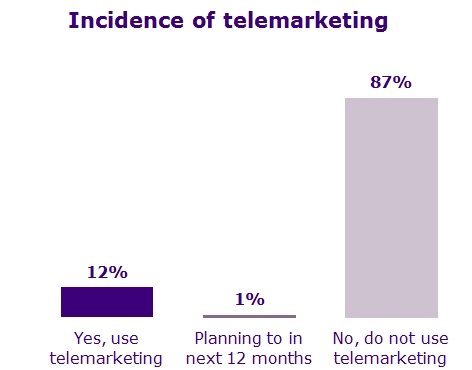
Q1 Does your organization ever use telephone calls to advertise, sell or otherwise promote products or services? This includes live or pre-recorded calls, and could be done either by internal staff or by another company on your behalf.
Q30 [IF NO] Do you have any plans to use telemarketing in the next 12 months, that is to use telephone calls, either live or pre-recorded, to sell, advertise or otherwise promote products or services?
BASE: Total sample
Profile of telemarketers vs. non-telemarketers. The following table presents a profile of telemarketers and non-telemarketers by business size, industry and region. The findings indicate that:
| Characteristic | Total (n=1,202) % |
Telemarketers (n=165) % |
Non-telemarketers (n=1,037) % |
|---|---|---|---|
| Business size (number of employees) | |||
| 1-4 employees | 39 | 25 | 41 |
| 5-9 employees | 23 | 22 | 24 |
| 10-49 employees | 28 | 37 | 27 |
| 50-99 employees | 8 | 13 | 7 |
| 100-499 employees | 2 | 4 | 1 |
| 500+ employees | <1 | - | <1 |
| Industry (top mentions) | |||
| Retail/automotive | 18 | 17 | 18 |
| Pharmaceuticals/health | 11 | 6 | 12 |
| Food/beverage/hospitality | 10 | 4 | 10 |
| Home construction/renovation | 9 | 10 | 9 |
| Manufactured goods | 7 | 11 | 6 |
| Banking/financial services | 4 | 3 | 4 |
| Real estate | 3 | 2 | 3 |
| Service/sales | 3 | 3 | 3 |
| Not-for-profit or NGO | 3 | 3 | 3 |
| Utilities | 3 | 3 | 2 |
| Exempt businesses** | 3 | 4 | 2 |
| Agriculture/farming | 2 | 4 | 1 |
| Government/public service | 2 | 3 | 2 |
| Region | |||
| Atlantic provinces | 7 | 6 | 7 |
| Quebec | 21 | 24 | 21 |
| Ontario | 35 | 40 | 34 |
| Manitoba/Saskatchewan | 7 | 6 | 7 |
| Alberta | 14 | 16 | 14 |
| British Columbia | 16 | 9 | 17 |
* Non-telemarketers includes businesses who plan to start telemarketing, since the base size (n=17) is too small to report separately
**Includes registered charities, media (newspapers/magazines), and research and public opinion firms
Canadian firms with no plans to use telemarketing typically say it is not an effective marketing strategy for their type of organization.
Organizations that don’t currently use telemarketing and that have no plans to do so in the next 12 months (87% of total sample) were asked why not. By far the most common reason is because they don’t see the value in it as marketing strategy for their organization (63%). Some companies also say they have no need of it, for example, because they are small and have sufficient business (10%) or rely on referrals (7%) or other advertising methods (5%). Other reasons include a personal distaste for telemarketing (18%), or the view that it is too costly (5%) or less efficient now that Canadians are answering their phones less (3%).
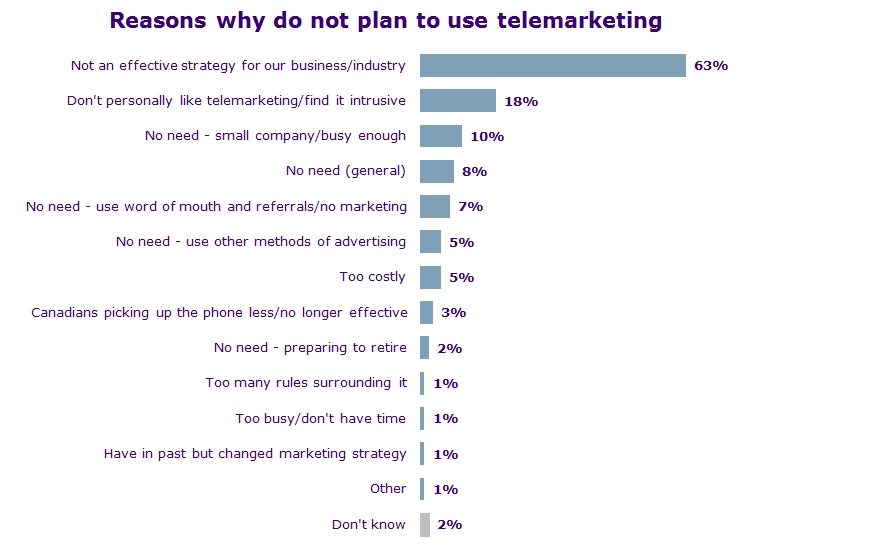
Q31 What are the main reasons why you don’t plan to use telemarketing?
BASE: Non-telemarketers (n=1,022)
Almost all telemarketers are telemarketing on behalf of their own business (rather than a client) and are making their own calls (either entirely or combined with a third party).
Among telemarketers, almost all (97%) say the calls are made on behalf of their own business (76%) or on behalf of both clients and their own business (21%). Only three percent are telemarketing on behalf of clients only. The regulations indicate that these businesses should be registered with the DNCL.
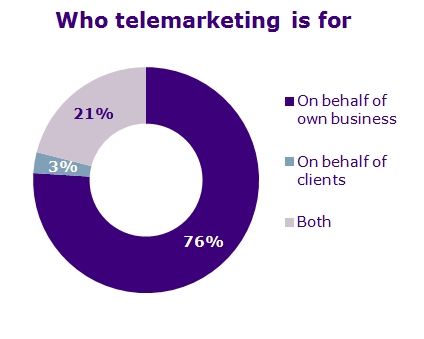
Q2 Are the calls made on behalf of your own business, on behalf of clients, or both?
BASE: Telemarketers (n=165)
The large majority of firms in all regions are telemarketing on their own behalf. However, firms in Quebec and the Atlantic provinces (35%) are more likely than those in Ontario (11%) to be telemarketing on both their own behalf and that of clients.
Among telemarketers whose calls are made on their own behalf, the very large majority (96%) are direct telemarketers, meaning they make their own calls entirely (90%) or together with a third party (6%). Only three percent are indirect telemarketers who outsource all of their telemarketing needs.

Q3 Does your company make its own calls or do you outsource to another company?
BASE: Telemarketers whose calls are made on their own behalf (n=161)
Once again, firms in Quebec and the Atlantic provinces (12%) are more likely than those in Ontario (less than one percent) to be both making their own calls and outsourcing.
Almost half of telemarketers say their calls are initiated from Ontario.
Telemarketing calls are most likely to be initiated from Ontario (45%), followed by Quebec (28%), Alberta (17%) and B.C. (14%). Fewer than one in ten businesses each say their calls are initiated from another province or territory. Given that most telemarketers are doing their own calling, it is not surprising that the province/region of initiation mirrors the province/region in which the business itself is located.
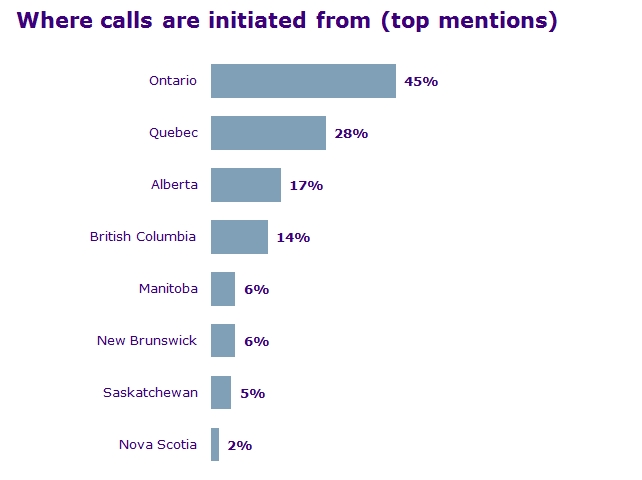
Where calls are initiated from (top mentions) - text version
Q4 Which province or territory are the calls initiated from?
BASE: Telemarketers (n=160)
Just under half of telemarketers are making calls to potential consumer clients. The other half say they are only targeting audiences that are exempt from the DNCL.
Telemarketers were asked if they make calls to any of the following audiences: potential consumer clients, existing consumer clients, potential business clients and existing business clients.
Just under half (46%) of telemarketers indicate that they are making calls to potential consumer clients with whom they do not already have an existing business relationship, meaning they are not exempt from the National DNCL rules.
The other half (52%) say they only make exempt telemarketing calls: to consumers with whom they have a pre-existing business relationship or to business clients (either potential or existing).
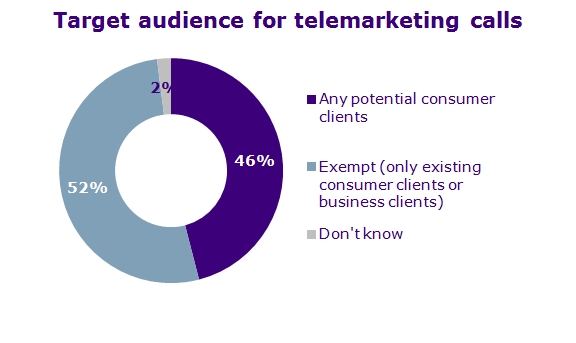
Q7 Are the telemarketing calls made to…?
BASE: Telemarketers (n=165)
English is the predominant language of telemarketing; three in ten do telemarketing in French.
Most businesses (87%) say they telemarket in English, while three in ten (31%) telemarket in French. A small minority (6%) telemarket in other languages.
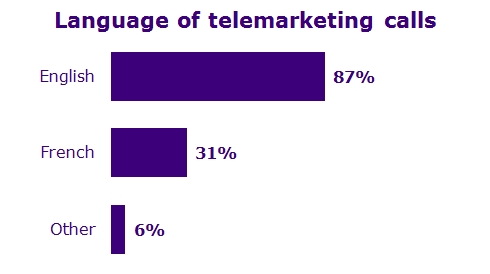
Q8 In what languages do you telemarket?
BASE: Telemarketers (n=165)
Firms in Quebec and the Atlantic provinces are by far the most likely to do telemarketing in French (82%). Telemarketing in languages other than English or French is most widespread among Ontario firms (13%).
The majority of telemarketers have been doing telemarketing for ten or more years.
Most firms have long-term experience with telemarketing. Two-thirds (66%) say they have been doing telemarketing for 10 years or more. The remainder are almost evenly divided between the newest telemarketers (16% for less than four years) and firms with medium-term experience (19% for between four and nine years).
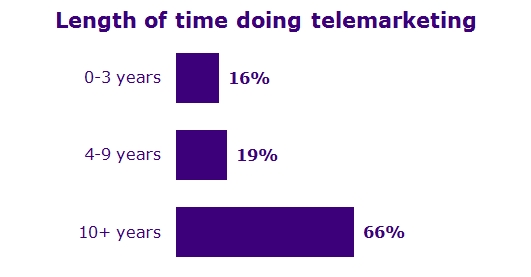
Q9 How long has your company been doing telemarketing?
BASE: Telemarketers (n=165)
On average, 28 percent of a telemarketer’s employees are engaged in telemarketing, although this is higher among smaller firms.
The proportion of employees engaged in telemarketing varies considerably by organization, with a reported average of 28 percent. This average is higher among small firms (29% of firms with less than 100 employees) than medium or large firms (19% of firms with 100 employees or more).
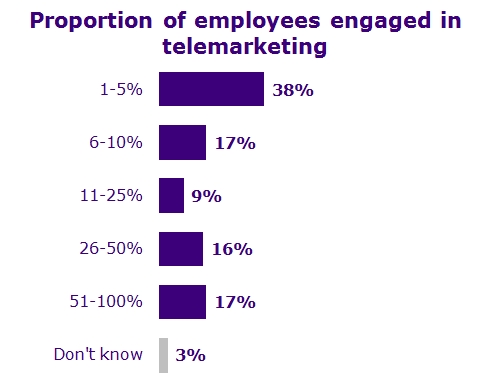
Proportion of employees engaged in telemarketing - text version
Q10 What proportion of your employees are engaged in telemarketing?
BASE: Direct telemarketers or those who telemarket on behalf clients (n=150)
The amount of revenue generated by telemarketing varies considerably.
Close to half (45%) of businesses say they generate less than $100,000 in annual revenue by telemarketing, while one in three (34%) generate more than that amount. The remaining one in five (21%) were unable or unwilling to provide an amount.
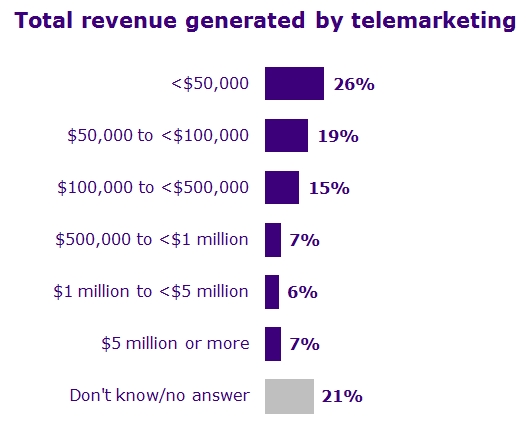
Q11 In order for us to classify your responses, which of the following best describes the total revenue your organization generates by telemarketing?
BASE: Telemarketers (n=165)
Small firms (less than 100 employees) are more likely to say that telemarketing generates less than $100,000 in revenue (46%), while medium and large firms (100 employees or more) are less inclined to answer the question altogether.
A majority of telemarketers say their telemarketing activity in the past year has been stable, while equal numbers say they did more or less than usual.
Change in telemarketing activity over the past year is balanced, with the proportion of telemarketers doing more than usual (17%) or just starting up (3%) comparable with the proportion who are doing less than usual (20%). Overall, the majority (59%) of telemarketers say their level of activity is stable.

Q12 Which of the following best describes your telemarketing activity in the past 12 months?
BASE: Telemarketers (n=165)
Increased telemarketing activity over the past year is more common among medium and large businesses (39% of firms with 100 or more employees) than small firms (17% with fewer than 100 employees).
Three in ten telemarketers expect their telemarketing activity to increase in the coming year, outweighing the proportion who expect it to decline – suggesting there will be growth in telemarketing activity overall.
Looking ahead over the next year, a majority (60%) of telemarketers continue to say their level of activity will remain the same. On balance, however, there are more telemarketers who expect their activity to increase (30%) than decrease (8%).
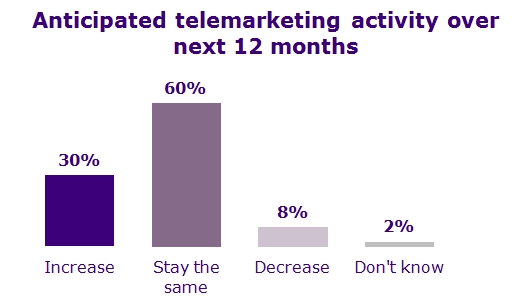
Anticipated telemarketing activity over next 12 months - text version
Q13 Over the next 12 months, will the amount of telemarketing your organization does…?
BASE: Telemarketers (n=165)
Increased telemarketing activity in the next 12 months is more widely anticipated by Quebec and Atlantic firms (42% vs. 17% of Ontario telemarketers), firms earning higher revenues as a result of their telemarketing activity (44% generating revenues over $100,000) and firms that are calling potential consumers (42%) rather than audiences that qualify as DNCL exemptions (21%).
Growth in telemarketing activity is also mostly widely expected by firms who already experienced telemarketing growth in the previous year (75%), thus continuing an already existing pattern for those organizations.
Reasons for increase. Telemarketers who plan to increase their telemarketing activity (30% of telemarketers) were asked the reasons why. They are most likely to cite reasons that indicate they believe it is an effective marketing tool, such as that it will improve sales (35%), make them more competitive (23%) or give them more exposure (18%), or that it has worked to increase sales in the past (21%). Some also indicate that they have the increased capacity necessary to grow their telemarketing activity (27%).
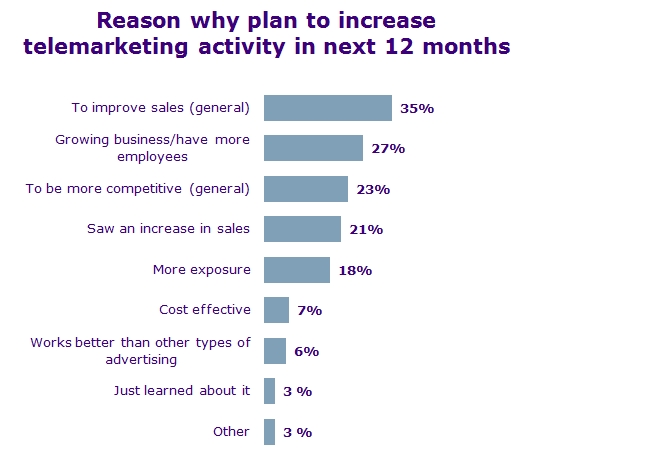
Reasons why plan to increase telemarketing activity in next 12 months - text version
Q14 What is the main reason why you plan to increase your telemarketing activity in the next 12 months?
BASE: Telemarketers who plan to increase their telemarketing activity (n=56)
Reasons for reduction. Telemarketers who plan to reduce their telemarketing activity (8% of telemarketers, representing n=11 respondents) generally say they made a strategic decision to change their marketing approach.
Seven in ten telemarketers are at least somewhat familiar with the DNCL, while minorities are familiar with ADAD and other telemarketing rules.
The majority of telemarketers (69%) say they are at least somewhat familiar with the National DNCL. There is considerably less familiarity with both the ADAD rules (25%) and other telemarketing rules (34%).
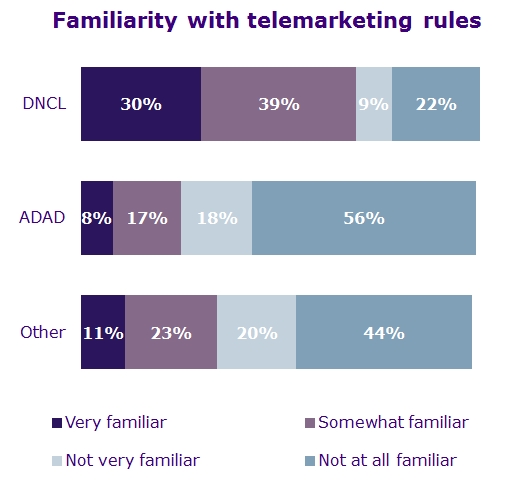
Q16 Would you say you are very familiar, somewhat familiar, not very familiar or not at all familiar with each of the following?
BASE: Telemarketers (n=165)
Strong familiarity (i.e., “very” familiar) with the DNCL is higher among Ontario firms (47%) and medium and large businesses (52%), as well as among firms that are calling potential consumers (40%) rather than audiences that qualify as DNCL exemptions (23%).
In turn, familiarity with both the DNCL and the ADAD rules is lowest in Quebec and the Atlantic provinces.
A minority of telemarketers familiar with the DNCL could identify the Government of Canada or the CRTC as the organization responsible.
More than four in ten telemarketers familiar with the DNCL identify the Government of Canada (24%) or the CRTC (20%) as the organization responsible. The remainder either incorrectly link the DNCL with a provincial government or a consumer protection organization, or cannot name the organization responsible.
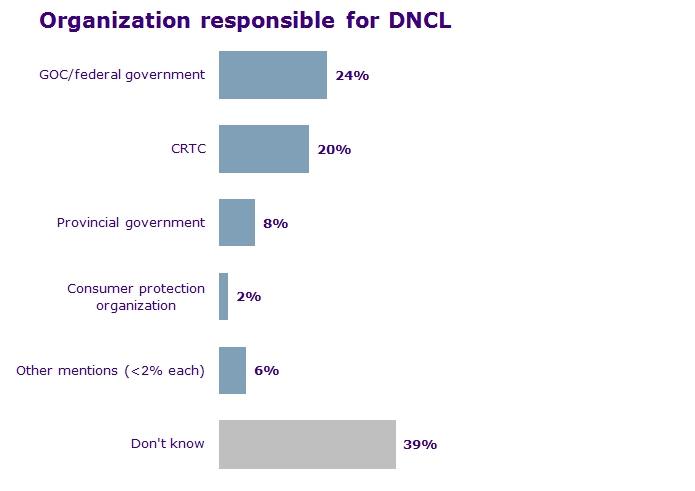
Q17 To the best of your knowledge, what organization is responsible for the National Do Not Call List?
BASE: Telemarketers familiar with the DNCL (n=132)
Those who are most familiar with the DNCL (i.e., “very” familiar) are more likely to identify the federal government as the responsible party (41%), but are no more likely than average to mention the CRTC (19%).
Six percent of all telemarketers say they have registered with the DNCL. Those who have not registered say they are not aware they had to or that they are exempted, and only three in ten intend to register in the coming year.
Telemarketers with at least some familiarity with the DNCL (78% of telemarketers) were asked if their organization is registered. Fewer than one in ten (8%) say that they are, representing six percent of all telemarketers. The majority (66%) say they are not registered while one in four (26%) are not sure.
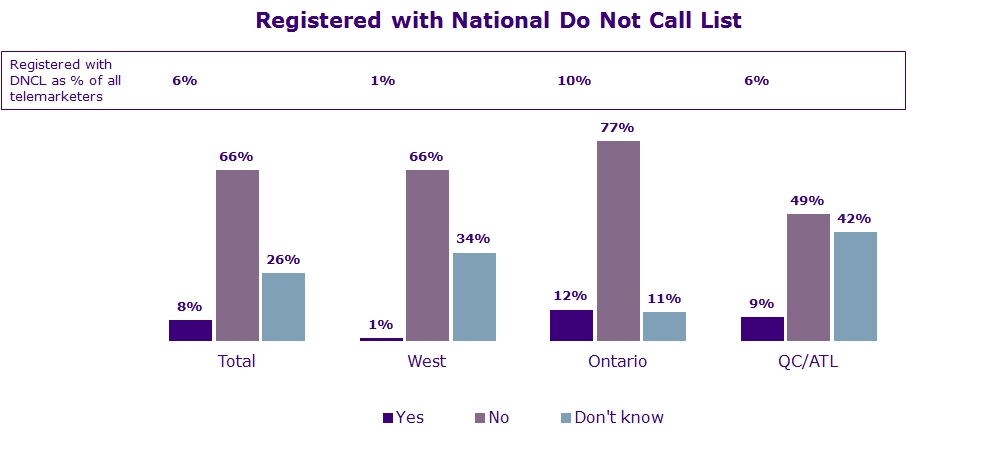
Q18 Is your company registered with the National Do Not Call List? Being registered means your business name, contact information and a brief description of your telemarketing activities have been entered on the National Do Not Call List website, and updated every 12 months.
BASE: Telemarketers familiar with DNCL (n=132)
Registration with the DNCL is more common in Ontario and Quebec and the Atlantic provinces than in the West.
Reasons why not registered. Telemarketers not registered with the DNCL were asked the reasons why not. The two main reasons are:
Very few say they aren’t registered because they keep their own internal DNC list (3%) or because the registration process is too complex (3%).
Notably, the reasons given are similar regardless of whether they are dialling audiences that qualify as DNCL exemptions or not.
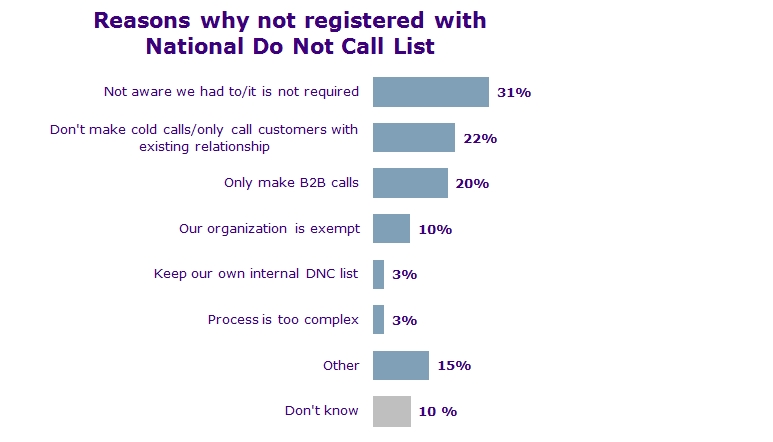
Reasons why not registered with National Do Not Call List - text version
Q19 Why have you not registered with the National Do Not Call List?
BASE: Telemarketers not registered with DNCL (n=79)
Likelihood to register. Just over one in ten (13%) telemarketers not already registered with the DNCL say they are very likely to do so in the next 12 months, which is the most accurate measure of intention. Another one in five (18%) say they are somewhat likely to, while the majority (67%) are not likely to.
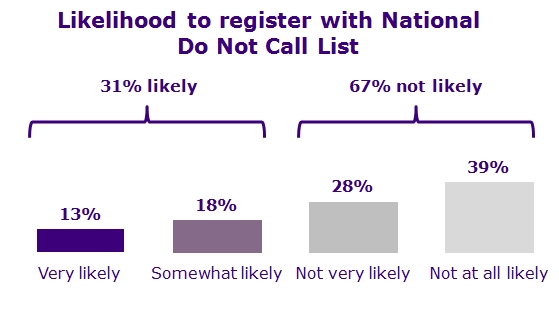
Likelihood to register with National Do Not Call List - text version
Q20 How likely is your organization to register with the National Do Not Call List in the next 12 months?
BASE: Telemarketers who are familiar with but not registered with DNCL (n=79)
Intention to register (very or somewhat) is higher among firms that are calling potential consumers (47%) rather than audiences that qualify as DNCL exemptions (16%).
A very small minority of telemarketers say they subscribe to the DNCL.
One in ten (10%) telemarketers registered with the DNCL say they subscribe to the list, which represents two percent of all telemarketers.
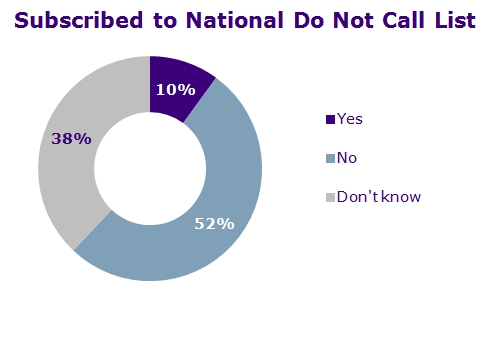
Q21 Does your company subscribe to the National Do Not Call List, meaning that you have purchased a list of telephone numbers to remove from your calling list?
BASE: Telemarketers registered with or uncertain whether they are registered with the DNCL (n=53)
Reasons why not subscribed. Telemarketers not subscribed to the DNCL (representing n=25 respondents, which is too small to report quantitatively) were asked the reasons why not. The two main reasons for not subscribing are not being aware that it is needed and being exempt (e.g., only calling customers with whom they have an existing business relationship, only making business-to-business calls).
Likelihood to register. This same small group of telemarketers not subscribed to the DNCL were asked how likely they are to do so in the next 12 months. As with likelihood to register, only a minority say they are likely to subscribe to the DNCL.
Most telemarketers would use an Internet search engine to find information about complying with telemarketing rules.
Telemarketers are most likely to use a search engine like Google (55%) or turn to the Internet generally (31%) to find information about complying with telemarketing rules. By comparison, relatively few know to go to the CRTC (5%) or DNCL (2%) websites, or would use an alternate source such as a consultant or a business association.
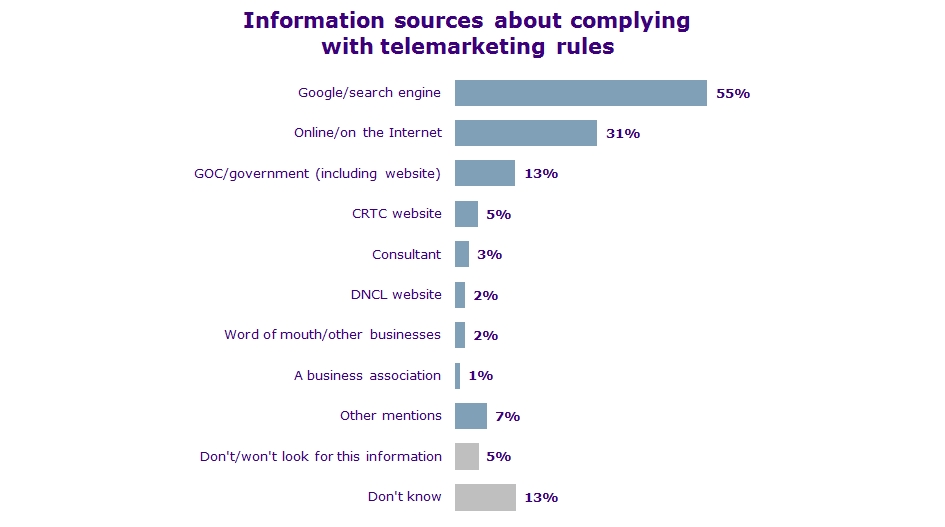
Information sources about complying with telemarketing rules - text version
Q24 If you wanted to find information about complying with telemarketing rules, where would you look?
BASE: Telemarketers (n=165)
A minority of telemarketers have ever visited the DNCL and CRTC websites.
One in five (19%) telemarketers say they have visited the DNCL website for information about compliance, while slightly fewer (15%) say the same about the CRTC website.

Visited DNCL and CRTC websites – among telemarketers - text version
Q25 Have you ever visited the National Do Not Call List website for information on compliance?
Q27 Have you ever visited the CRTC website for information on compliance with telemarketing rules?
BASE: Telemarketers (n=165)
For both the DNCL and CRTC sites, these visits occur no more than a few times a year, and most visitors say they happen less than once a year.
The main suggestions for helpful tools and resources include those that are directly addressed to businesses, rather than broader information campaigns.
When asked what type of information, tools or resources about complying with the DNCL would be most helpful to them, a majority of telemarketers (54%) are unable to name any. The main suggestions include direct-to-business tools such information bulletins, direct mail and emails.

Helpful tools/resources for complying with DNCL - text version
Q29 What information, tools or resources could be provided to help companies like yours comply with the National Do Not Call List?
BASE: Telemarketers (n=165)
More than six in ten non-telemarketers are at least somewhat familiar with the DNCL, while very few are familiar with ADAD and other telemarketing rules.
The majority of non-telemarketers (64%) say they are at least somewhat familiar with the DNCL, similar to the proportion among telemarketers (69%). By comparison, there is very little familiarity with both the ADAD rules (16%) and other telemarketing rules (16%) – and these proportions are lower than among telemarketers (25% and 34%, respectively).
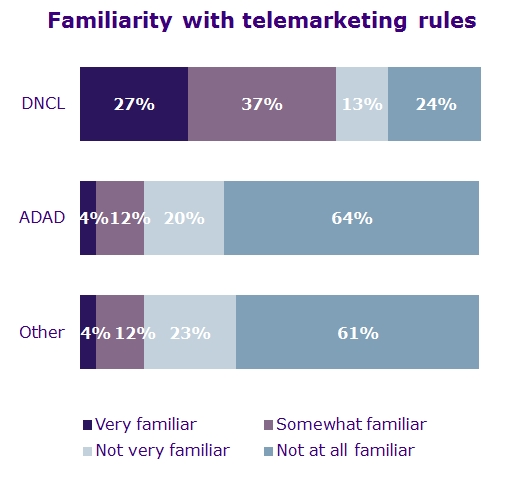
Familiarity with telemarketing rules – among non-telemarketers - text version
Q39 Would you say you are very familiar, somewhat familiar, not very familiar or not at all familiar with each of the following?
BASE: Non-telemarketers (n=1,037)
Strong familiarity (i.e., “very” familiar”) with the DNCL is highest among Ontario firms (36%) and lowest in Quebec and the Atlantic provinces (15%). Non-telemarketers in Quebec and the Atlantic provinces are also less likely than those in other regions to be familiar with ADAD and other telemarketing rules.
A minority of non-telemarketers familiar with the DNCL could identify the Government of Canada or the CRTC as the organization responsible.
Almost four in ten non-telemarketers familiar with the DNCL identify the Government of Canada (24%) or the CRTC (13%) as the organization responsible. The remainder either incorrectly link the DNCL with a provincial government or a consumer protection organization, or cannot name the organization responsible.
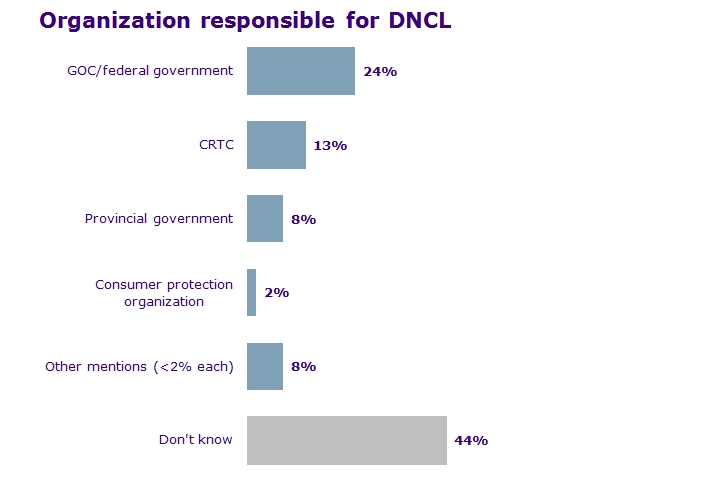
Organization responsible for DNCL – among non-telemarketers - text version
Q40 To the best of your knowledge, what organization is responsible for the National Do Not Call List?
BASE: Non-telemarketers familiar with the DNCL (n=810)
Most telemarketers would use an Internet search engine to find information about complying with telemarketing rules.
Nine percent of non-telemarketers have looked for information on compliance with telemarketing rules (Questions 41 and 42).
As is the case with telemarketers, non-telemarketers who plan to start telemarketing in the next 12 months or who have ever looked for compliance information are most likely to use a search engine like Google (55%) or turn to the Internet generally (38%) to find information about complying with telemarketing rules. By comparison, relatively few know to go to the CRTC (5%) or DNCL (1%) websites, or would use an alternate source such as a consultant or a business association.
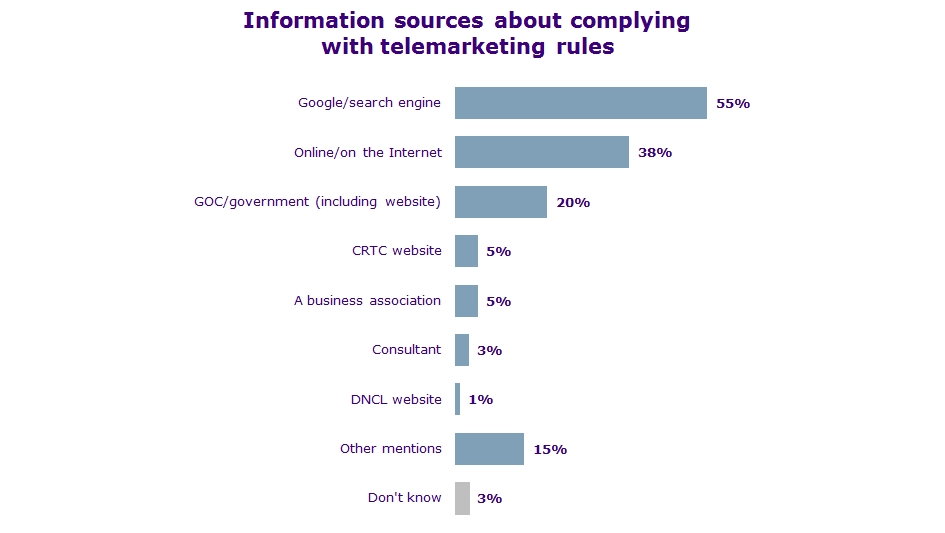
Q43 If you wanted to find information about complying with telemarketing rules, where would you look?
BASE: Non-telemarketers who are planning to start telemarketing in next 12 months, or who ever looked for information on compliance (n=111)
A minority of telemarketers have ever visited the DNCL and CRTC websites.
Among non-telemarketers who plan to start telemarketing in the next 12 months or who have ever looked for compliance information, more than four in ten (44%) say they have visited the DNCL website for information about compliance, while close to three in ten (28%) say the same about the CRTC website. It is important to note that these proportions cannot be directly compared to telemarketers, because they are based on non-telemarketers who have already shown interest in this type of information (i.e., have said they have previously looked for information on compliance).
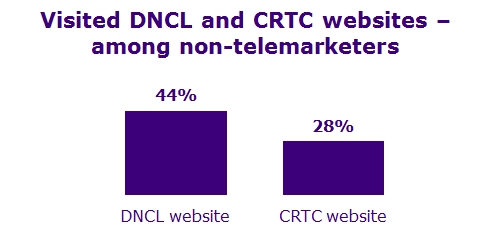
Visited DNCL and CRTC websites – among non-telemarketers - text version
Q44 Have you ever visited the National Do Not Call List website for information on compliance?
Q45 Have you ever visited the CRTC website for information on compliance with telemarketing rules?
BASE: Non-telemarketers who are planning to start telemarketing in next 12 months, or who ever looked for information on compliance (n=111)
Among the variety of suggestions for helpful tools and resources include emails, information bulletins and evidence of enforcement activities.
Among non-telemarketers who plan to start telemarketing in the next 12 months or who have ever looked for compliance information, when asked what type of information, tools or resources about complying with the DNCL would be most helpful to them, a majority (55%) are unable to name any. Those able to provide suggestions include emails, information bulletins and evidence of enforcement activities.
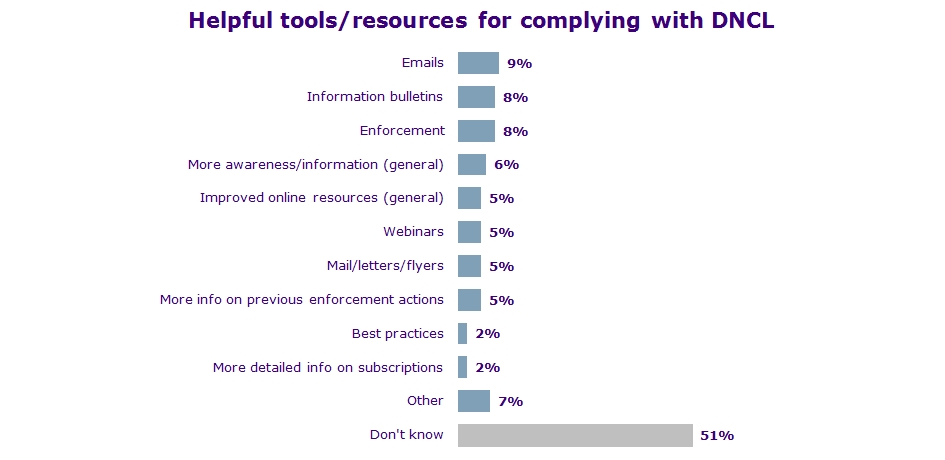
Helpful tools/resources for complying with DNCL – among non-telemarketers - text version
Q46 What information, tools or resources could be provided to help companies like yours comply with the National Do Not Call List?
BASE: Non-telemarketers who are planning to start telemarketing in next 12 months, or who ever looked for information on compliance (n=111)
The results are based on telephone interviews conducted with a representative sample of 1,202 Canadian businesses, between February 23 and March 15, 2016. The margin of error for a sample of 1,202 is +/- 2.8 percentage points, in 19 out of 20 samples. The margin of error is greater for results pertaining to subgroups of this population, such as telemarketers.
A telephone survey was considered to be the best methodology to obtain information from the target audience of Canadian businesses. This audience is not included in online panels in sufficient numbers to be fully representative of the Canadian business universe. Also, because online surveys involved non-random probability samples, a margin of sampling error cannot be cited.
The sampling method was designed to complete 1,200 interviews with the target audience of Canadian businesses. All Canadian business were considered eligible for the study; that is, the survey was designed to include both businesses who participate in telemarketing activities and those who do not, nor did it exclude businesses exempt from the UTRs (registered charities, newspapers and market research firms).
The sample was stratified by business size (number of employees) within region, in order to provide a sufficient number of medium (100-499 employees) and large (500+ employees) businesses for analysis.
The data are statistically weighted to ensure the sample is as representative of this population as possible, according to the most recently available Statistics Canada information (2012). The table below outlines the unweighted and weighted sample distribution and the associated margin of sampling error.
| Weighted | Unweighted | Margin of Error* | |
|---|---|---|---|
| Number of employees | |||
| Small (1-99) | 1,181 | 1,000 | +/- 2.0 |
| Medium (100-499) | 20 | 100 | +/- 9.8 |
| Large (500+) | 2 | 102 | +/- 9.8 |
| Region | |||
| Atlantic provinces | 85 | 85 | +/- 10.6 |
| Quebec | 257 | 252 | +/- 6.2 |
| Ontario | 422 | 420 | +/- 4.8 |
| Manitoba/Saskatchewan | 80 | 85 | +/- 10.6 |
| Alberta | 168 | 168 | +/- 7.6 |
| British Columbia | 189 | 192 | +/- 7.1 |
*Margin of sampling error at the 95% confidence level
The questionnaire used for this survey was designed by Environics in conjunction with the CRTC project team. Once the questionnaire was finalized and approved by the CRTC, the CRTC translated it into French. A copy of the English and French language versions of the questionnaire are attached as an appendix.
Pre-test. Prior to finalizing the survey for field, Environics conducted a full pre-test with “live” respondents. This consisted of telephone interviews in the same manner as for the full survey, but with a small sample of respondents (10 English and 10 French). Recordings of the interviews were audited by Environics’ senior research consultant. Following the pre-test, a small number of refinements were made and approved by the CRTC.
The interviewing was conducted by Elemental Data Collection Inc. of Ottawa, ON, between February 23 and March 15, 2016. Field supervisors were present at all times to ensure accurate interviewing and recording of responses. Ten percent of each interviewer’s work was unobtrusively monitored for quality control in accordance with the standards set out by the Marketing Research and Intelligence Association (MRIA).
Up to eight callbacks were made to reach each business selected in the sample, and such calls were made at different times of the day and days of the week, to maximize the chances of reaching the appropriate individual. All surveys were conducted in respondents’ official language of choice. This survey was registered with the MRIA’s registration system.
The effective response rate for the survey is 19 percent. This is calculated as the number of responding participants (completed interviews and over-quota participants), divided by unresolved numbers (busy, no answer) plus non-responding businesses or individuals (refusals, language barrier, missed callbacks) plus responding participants:[R/(U+IS+R)]. The following table presents the final disposition of all numbers dialled.
| TOTAL | |
|---|---|
| Total Numbers Attempted | 7850 |
| Out-of-scope – Invalid | 1009 |
| Unresolved (U) | 2736 |
| No answer/Answering machine | 2736 |
| In-scope – Non-responding (IS) | 1990 |
| Language barrier | 26 |
| Incapable of completing (ill/deceased) | 9 |
| Callback (Respondent not available) | 1955 |
| Total Asked | 2115 |
| Refusal | 785 |
| Termination | 40 |
| In-scope – Responding units (R) | 1290 |
| Completed Interview | 1202 |
| Quota full – Company Size | 88 |
| Response Rate (%) | 18.86 |
| Incidence | 93.18 |
Environics Research Group
February 24, 2016
CRTC
Telemarketing in Canada
FINAL Questionnaire
Telephone survey with 1200 Canadian businesses
Introduction
Hello, my name is _______________ and I am calling from Environics, a public opinion research company. Would you prefer that I continue in English or French? Préférez-vous continuer en français ou en anglais?
RECORD LANGUAGE OF INTERVIEW
Today we are conducting a survey with businesses and other organizations across Canada about how they communicate with their customers or clients. Could I please speak to the person who makes decisions about marketing for your business or organization?
01 – Yes, speaking
02 – Yes, will transfer RECORD NAME & TITLE
03 – No, not interested THANK AND TERMINATE
IF YES, SPEAKING: This is not a sales call. We are not selling or soliciting anything, we simply want to ask your opinions. This survey is registered with the national survey registration system. GO TO Q.B
WHEN RESPONDENT IS ON THE LINE: Hello, my name is _______________ and I am calling from Environics, a public opinion research company. Would you prefer that I continue in English or French? Préférez-vous continuer en français ou en anglais?
Today we are conducting a survey with businesses across Canada about how they communicate with customers or clients. Please be assured that we are not selling or soliciting anything, we simply want to ask your opinions. This survey is registered with the national survey registration system. First I have a few questions to make sure that you qualify for the study.
A. Do you make decisions about marketing for your business or organization?
01 – Yes
02 – No RECORD NAME AND TITLE – ASK TO SPEAK TO THAT PERSON
IF PERSON IS NOT CURRENTLY AVAILABLE, ARRANGE FOR CALL-BACK
IF ASKED: Your company is one of 1200 businesses and other organizations selected at random from a published list to be included in this survey. This includes charities, non-profit organizations and public sector/government.
IF ASKED: The survey will take about 10 minutes to complete
IF ASKED: This survey is being conducted on behalf of the Government of Canada. Your responses are anonymous and the information you provide will be used for statistical purposes only.
IF ASKED: The registration system has been created by the Canadian survey research industry to allow the public to verify that a survey is legitimate, get information about the survey industry or register a complaint. The registration system’s toll-free telephone number is 1-800-554-9996.
Screening
B. Including yourself, how many employees does your company have? Please include both full-time and part-time employees, across all locations.
READ ONLY IF NECESSARY
01 – 1 to 4 employees
02 – 5 to 9 employees
03 – 10 to 49 employees
04 – 50 to 99 employees
05 – 100 to 499 employees
06 – 500 or more employees
VOLUNTEERED
99 – DK/NA THANK AND TERMINATE
IF ASKED: This includes both cold calling and calls made to customers with whom you have an existing relationship.
IF ASKED: This refers to outgoing calls only, not incoming calls/requests.
IF ASKED: This could either be on behalf of your own company or for clients.
01 - Yes CONTINUE
02 – No SKIP TO Q.30 (Section for non-telemarketers)
READ TO ALL: For the purpose of the survey, I will use the word telemarketing to refer to this activity.
Telemarketers (“yes” to Q1)
01 – On behalf of own business
02 – On behalf of clients SKIP TO Q.4
03 – Both
99 – DK/NA
01 – Make own calls
02 – Outsource
03 – Both
99 – DK/NA
[IF Q3=03 BOTH] For the calls your company makes itself, which province or territory are the calls initiated from?
DO NOT READ – CODE ALL THAT APPLY.
01 - Alberta
02 - British Columbia
03 - Manitoba
04 - New Brunswick
05 - Newfoundland and Labrador
06 – Northwest Territories
07 - Nova Scotia
08 – Nunavut
09 - Ontario
10 - Prince Edward Island
11 - Quebec
12 - Saskatchewan
13 – Yukon
99 – DK/NA
[IF Q3=03 BOTH] For the telemarketing that you outsource, where is the telemarketing service you use located?
DO NOT READ – CODE ALL THAT APPLY.
CANADA
01 - Alberta
02 - British Columbia
03 - Manitoba
04 - New Brunswick
05 - Newfoundland and Labrador
06 – Northwest Territories
07 - Nova Scotia
08 – Nunavut
09 - Ontario
10 - Prince Edward Island
11 - Quebec
12 - Saskatchewan
13 – Yukon
14 – In Canada (not sure which province/territory)
INTERNATIONAL
15 – U.S.
16 – India
17 – Pakistan
18 – Philippines
19 – Outside Canada (not sure where)
97 – Other (SPECIFY)
99 – DK/NA
DO NOT READ LIST – CLARIFY ONLY IF NECESSARY.
01 - Advertising/ Communications/Marketing
02 - Banking / Investing / lending/ Financial Services / advisors / Insurance /bankruptcy/Debt Collection etc.
03 - Charity - Registered
04 - Education
05 - Food & Beverages, Hospitality
06 - Government / Public service
07 - Home construction, Renovation, maintenance/Windows and Doors
08 - Manufactured Goods
09 - Media (Newspapers, Magazines)
10 - Not-for profit or NGO
11 - Pharmaceuticals / Health
12 - Political Parties
13 - Real Estate
14 - Research and Public Opinion
15 - Retail /Automotive
16 - Security, IT
17 - Telemarketing/Call centre
18 - Telephone, Television, Internet
19 - Travel and Vacation
20 - Utilities (eg. Hydro and Gas)
97 – Other (SPECIFY)
99 – DK/NA
READ – RECORD ALL THAT APPLY
01 – Potential consumer clients
02 – Existing consumer clients
03 – Potential business clients
04 – Existing business clients
VOLUNTEERED
99 – DK/NA
DO NOT READ – CODE ALL THAT APPLY.
01 – English
02 – French
97 – Other (SPECIFY)
99 – DK/NA
READ
01 – 0-3 years
02 – 4-9 years
03 – 10 or more years
VOLUNTEERED
99 – DK/NA
____ _____ _____% [ACCEPT ESTIMATE BUT NOT A RANGE]
999 – DK/NA
READ LIST – STOP WHEN REACH APPROPRIATE CATEGORY
01 - Less than $50,000
02 - $50,000 to less than $100,000
03 - $100,000 to less than $500,000
04 - $500,000 to less than $1 million
05 - $1 million to less than $5 million
06 - $5 million or more
VOLUNTEERED
99 - DK/NA
READ
01 - Did more than usual
02 - Did less than usual
03 - Did the same
04 – [ONLY SHOW IF Q9=01] Just started in the last 12 months
VOLUNTEERED
99 – DK/NA
READ
01 – Increase
02 – Decrease
03 – or, stay the same SKIP TO Q.16
VOLUNTEERED
99 – DK/NA SKIP TO Q.16
DO NOT READ – RECORD ALL THAT APPLY
01 - Cost effective
02 - Saw an increase in sales
03 - Works better than other types of marketing
04 - More exposure
05 – Just learned about it
97 – Other (SPECIFY)
99 – DK/NA
DO NOT READ – RECORD ALL THAT APPLY
01 - Too costly
02 - Saw a decrease in sales
03 - Change in marketing strategy
04 - Canadians are picking the phone less to unknown numbers
97 – Other (SPECIFY)
99 – DK/NA
READ IN ORDER SHOWN
a. The National Do Not Call List, which is a list of telephone numbers of consumers who have chosen to reduce the number of telemarketing calls they receive
b. The Automatic Dialing and Announcing Device, or ADAD, rules
c. Other telemarketing rules
01 – Very familiar
02 – Somewhat familiar
03 – Not very familiar
04 – Not at all familiar
VOLUNTEERED
99 – DK/NA
DO NOT READ – RECORD ONE ONLY
01 – CRTC
02 – Government – PROBE FOR LEVEL OF GOVERNMENT
03 – Government of Canada/federal government
04 – Bell Canada
97 – Other (SPECIFY)
99 – DK/NA
01 – Yes SKIP TO Q.21
02 – No
99 – DK/NA SKIP TO Q.21
DO NOT READ – RECORD ALL THAT APPLY
01 – Cost is too high
02 – Process is too complex
03 – Not aware that we had to/it is not required
04 – Our organization is exempt
05 – We only make B2B/business-to-business calls
06 – We keep our own internal do not call list
07 – We are a telemarketing company making calls on behalf of clients
08 – We don’t make cold calls/only call customers that have existing relationships with
97 – Other (SPECIFY)
99 – DK/NA
READ
01 – Very likely
02 – Somewhat likely
03 – Not very likely
04 – Not at all likely
VOLUNTEERED
99 – DK/NA
01 – Yes SKIP TO Q.24
02 – No
99 – DK/NA SKIP TO Q.24
DO NOT READ – RECORD ALL THAT APPLY
01 – Subscription provided by client
02 – Cost is too high
03 – Process is too complex
04 – The list is difficult to use
05 – Our company is exempt
06 – We only make B2B/business-to-business calls
07 – Not aware that a subscription was needed
08 – We keep our own internal do not call list
09 – We don’t make cold calls/only call customers that we have existing relationships with
97 – Other (SPECIFY)
99 – DK/NA
READ
01 – Very likely
02 – Somewhat likely
03 – Not very likely
04 – Not at all likely
VOLUNTEERED
99 – DK/NA
DO NOT READ – RECORD ALL THAT APPLY
01 - I don’t/won’t look for this information
02 - Consultant
03 - Word of mouth (other businesses)
04 - A business association
04 - DNCL website
05 - CRTC website
06 – Google/search engine
07 – Online/on the Internet (PROBE FOR WHERE)
97 – Other (SPECIFY)
99 – DK/NA
01 - Yes
02 – No SKIP TO Q.27
99 – DK/NA SKIP TO Q.27
READ
01 - Once a week or more
02 - Once a month
03 - A few times a year
04 - Less than once a year
VOLUNTEERED
99 – DK/NA
01 - Yes
02 – No SKIP TO Q.29
99 – DK/NA SKIP TO Q.29
READ
01 - Once a week or more
02 - Once a month
03 - A few times a year
04 - Less than once a year
VOLUNTEERED
99 – DK/NA
DO NOT READ – RECORD ALL THAT APPLY
01 - Information bulletins
02 - Webinars
03 – FAQs (frequently asked questions)
04 - Best Practices
05 - More information on previous enforcement actions
06 - Scrubbed list (list of phone numbers allowed to call)
07 - More detailed information on subscription options
97 – Other (SPECIFY)
99 – DK/NA
NOW SKIP TO SURVEY END Non-Telemarketers (“no” to Q1)
01 – Yes SKIP TO Q.32
02 – No
99 – DK/NA
DO NOT READ – RECORD ALL THAT APPLY
01 – Too costly
02 – Too many rules surrounding the activity
03 – Have done telemarketing in past but changed marketing strategy
04 – Canadians are picking up the phone less to unknown numbers/no longer effective
05 – Not an effective strategy for our business/industry
06 – Don’t personally like telemarketing/find it intrusive
97 – Other (SPECIFY)
99 – DK/NA
31a. In which industry or sector does your organization operate?
DO NOT READ LIST – CLARIFY ONLY IF NECESSARY.
01 - Advertising/ Communications/Marketing
02 - Banking / Investing / lending/ Financial Services / advisors / Insurance /bankruptcy/Debt Collection etc.
03 - Charity - Registered
04 - Education
05 - Food & Beverages, Hospitality
06 - Government / Public service
07 - Home construction, Renovation, maintenance/Windows and Doors
08 - Manufactured Goods
09 - Media (Newspapers, Magazines)
10 - Not-for profit or NGO
11 - Pharmaceuticals / Health
12 - Political Parties
13 - Real Estate
14 - Research and Public Opinion
15 - Retail /Automotive
16 - Security, IT
17 - Telemarketing/Call centre
18 - Telephone, Television, Internet
19 - Travel and Vacation
20 - Utilities (eg. Hydro and Gas)
97 – Other (SPECIFY)
99 – DK/NA
NOW SKIP TO Q.39
ASK Q.32-39 ONLY IF PLAN TO TELEMARKET (Q30=01)
01 – On behalf of own business
02 – On behalf of clients SKIP TO Q.34
03 – Both
99 – DK/NA
01 – Make own calls
02 – Outsource
03 – Both
99 – DK/NA
[IF Q33=03 BOTH] For the calls your company will make itself, which province or territory will the calls be initiated from?
DO NOT READ – CODE ALL THAT APPLY.
01 - Alberta
02 - British Columbia
03 - Manitoba
04 - New Brunswick
05 - Newfoundland and Labrador
06 – Northwest Territories
07 - Nova Scotia
08 – Nunavut
09 - Ontario
10 - Prince Edward Island
11 - Quebec
12 - Saskatchewan
13 – Yukon
99 – DK/NA
[IF Q33=03 BOTH] For the telemarketing that you will outsource, where is the telemarketing service that you will use located?
DO NOT READ – CODE ALL THAT APPLY.
CANADA
01 - Alberta
02 - British Columbia
03 - Manitoba
04 - New Brunswick
05 - Newfoundland and Labrador
06 – Northwest Territories
07 - Nova Scotia
08 – Nunavut
09 - Ontario
10 - Prince Edward Island
11 - Quebec
12 - Saskatchewan
13 – Yukon
14 – In Canada (not sure which province/territory))
INTERNATIONAL
15 – U.S.
16 – India
17 – Pakistan
18 – Philippines
19 – Outside Canada (not sure where)
97 – Other (SPECIFY)
99 – DK/NA
DO NOT READ LIST – CLARIFY ONLY IF NECESSARY.
01 - Advertising/ Communications/Marketing
02 - Banking / Investing / lending/ Financial Services / advisors / Insurance /bankruptcy/Debt Collection etc.
03 - Charity - Registered
04 - Education
05 - Food & Beverages, Hospitality
06 - Government / Public service
07 - Home construction, Renovation, maintenance/Windows and Doors
08 - Manufactured Goods
09 - Media (Newspapers, Magazines)
10 - Not-for profit or NGO
11 - Pharmaceuticals / Health
12 - Political Parties
13 - Real Estate
14 - Research and Public Opinion
15 - Retail /Automotive
16 - Security, IT
17 - Telemarketing/Call centre
18 - Telephone, Television, Internet
19 - Travel and Vacation
20 - Utilities (eg. Hydro and Gas)
97 – Other (SPECIFY)
99 – DK/NA
READ – RECORD ALL THAT APPLY
01 – Potential consumer clients
02 – Existing consumer clients
03 – Potential business clients
04 – Existing business clients
VOLUNTEERED
04 – Other/none of the above
DO NOT READ – CODE ALL THAT APPLY.
01 – English
02 – French
97 – Other (SPECIFY)
99 – DK/NA
ASK Q39-40 OF ALL NON-TELEMARKETERS (“no” at Q.1)
READ IN ORDER SHOWN
a. The National Do Not Call List, which is a list of telephone numbers of consumers who have chosen to reduce the number of telemarketing calls they receive
b. The Automatic Dialing and Announcing Device, or ADAD, rules
c. Other telemarketing rules
01 – Very familiar
02 – Somewhat familiar
03 – Not very familiar
04 – Not at all familiar
VOLUNTEERED
99 – DK/NA
DO NOT READ – RECORD ONE ONLY
01 – CRTC
02 – Government – PROBE FOR LEVEL OF GOVERNMENT
03 – Government of Canada/federal government
04 – Bell Canada
97 – Other (SPECIFY)
99 – DK/NA
ASK Q41 ONLY IF PLANNING TO TELEMARKET (Q.30=01)
01 - Yes
02 – No
99 – DK/NA
ASK Q42 ONLY IF NOT PLANNING TO TELEMARKET (Q.30=02)
01 - Yes
02 – No SKIP TO SURVEY END
99 – DK/NA SKIP TO SURVEY END
DO NOT READ – RECORD ALL THAT APPLY
02 - Consultant
03 - Word of mouth (other businesses)
04 - A business association
04 - DNCL website
05 - CRTC website
06 – Google/search engine
07 - Online – Specify
97 – Other (SPECIFY)
99 – DK/NA
01 - Yes
02 – No
99 – DK/NA
01 - Yes
02 – No
99 – DK/NA
DO NOT READ – RECORD ALL THAT APPLY
01 - Information bulletins
02 - Webinars
03 – FAQs (frequently asked questions)
04 - Best Practices
05 - More information on previous enforcement actions
06 - Scrubbed list (list of phone numbers allowed to call)
07 - More detailed information on subscription options
97 – Other (SPECIFY)
99 – DK/NA
SURVEY END
Those are all the questions we have for you today. This survey was conducted on behalf of the Government of Canada. Thank you very much for your participation.
RECORD:
01 - Alberta
02 - British Columbia
03 - Manitoba
04 - New Brunswick
05 - Newfoundland and Labrador
06 – Northwest Territories
07 - Nova Scotia
08 – Nunavut
09 - Ontario
10 - Prince Edward Island
11 - Quebec
12 - Saskatchewan
13 – Yukon
99 – DK/NA
Environics Research Group
16 février 2016
CRTC
Le télémarketing au Canada
Questionnaire
Sondage téléphonique auprès de 1200 entreprises canadiennes
Introduction
Bonjour, je m’appelle _______________ et je vous téléphone au nom d’Environics, une firme de recherche sur l’opinion publique. Préférez-vous continuer en français ou en anglais? Would you prefer that I continue in English or French?
NOTEZ LA LANGUE DE L’ENTREVUE
Aujourd’hui, nous effectuons un sondage auprès des entreprises et autres organismes dans l’ensemble du Canada sur leurs méthodes de communication avec les consommateurs ou leurs clients. Est-ce que je pourrais parler à la personne qui prend les décisions en matière de marketing pour votre entreprise ou votre organisation?
01 – Oui, c’est moi
02 – Oui, je vous transfère NOTEZ LE NOM ET LE TITRE
03 – Non, cela ne nous intéresse pas REMERCIEZ ET CONCLUEZ L’APPEL
POUR OUI, C’EST MOI : Tout d’abord, je tiens à préciser qu’il ne s’agit pas d’un appel de vente. Soyez assuré que nous ne cherchons ni à vendre, ni à solliciter, nous voulons tout simplement connaître votre opinion. Cette étude a été inscrite dans le système national d’enregistrement des sondages. PASSEZ AUX QUESTIONS
QUAND LE RÉPONDANT EST EN LIGNE : Bonjour, je m’appelle _______________ et je vous téléphone au nom d’Environics, une firme de recherche sur l’opinion publique. Préférez-vous continuer en français ou en anglais? Would you prefer that I continue in English or French?
Aujourd’hui, nous effectuons un sondage qui s’adresse aux entreprises et autres organismes dans l’ensemble du Canada pour savoir comment ils communiquent avec les consommateurs ou leurs clients. Soyez assuré que nous ne cherchons ni à vendre, ni à solliciter, nous voulons tout simplement connaître votre opinion. Cette étude a été inscrite dans le système national d’enregistrement des sondages. Avant de poursuivre, je dois vous poser quelques questions pour m’assurer que vous répondez aux critères de la recherche.
A. Est-ce vous qui prenez les décisions concernant le marketing pour votre entreprise ou votre organisation?
01 – Oui
02 – Non NOTEZ LE NOM ET LE TITRE – DEMANDEZ SI VOUS POUVEZ
PARLER À CETTE PERSONNE
SI LA PERSONNE N’EST PAS LIBRE, DEMANDEZ À QUEL MOMENT VOUS POUVEZ LA RAPPELER
SI ON VOUS LE DEMANDE : Votre entreprise fait partie des 1 200 entreprises et organismes sélectionnés au hasard sur les listes publiques pour participer à ce sondage. Les organismes de bienfaisance, les organismes sans but lucratif et les services publics et gouvernementaux sont admissibles.
SI ON VOUS LE DEMANDE : L’étude dure environ 10 minutes.
SI ON VOUS LE DEMANDE : Ce sondage est effectué au nom du gouvernement du Canada. Vos réponses seront anonymes et les renseignements que vous fournirez ne seront utilisés qu’à des fins statistiques.
SI ON VOUS LE DEMANDE : L’industrie de la recherche par sondages au Canada a mis sur pied un système d’enregistrement pour permettre au public de s’informer sur la légitimité des sondages, d’obtenir des renseignements sur l’industrie de la recherche par sondages ou de déposer une plainte. Le numéro sans frais du système d’enregistrement est le 1-800-554-9996.
Présélection
B. En plus de vous-même, combien d’employés votre entreprise compte-t-elle? Il peut s’agir d’employés à plein temps ou à temps partiel, à travers tous vos locaux.
À LIRE AU BESOIN
01 – 1 à 4 employés
02 – 5 à 9 employés
03 – 10 à 49 employés
04 – 50 à 99 employés
05 – 100 à 499 employés
06 – 500 employés ou plus
RÉPONSE SPONTANÉE
99 – NSP/SO REMERCIEZ ET CONCLUEZ L’APPEL
SI ON VOUS LE DEMANDE : Ceci inclut à la fois la sollicitation à froid et les appels effectués à des clients avec qui vous avez une relation d’affaires.
SI ON VOUS LE DEMANDE : Il ne s’agit que des appels sortants seulement, pas des appels ou des demandes que l’organisme reçoit.
SI ON VOUS LE DEMANDE : Il peut s’agir d’appels pour le compte de votre compagnie ou pour des clients.
01 - Oui CONTINUEZ
02 – Non PASSEZ À LA Q.30 (Section pour les non-télévendeurs)
À LIRE DANS TOUS LES CAS : Dans le cadre du sondage, je parlerai de « télémarketing » pour désigner tous les aspects de cette activité.
Télévendeurs (« oui » à Q1)
01 – Pour le compte de l’entreprise
02 – Pour le compte de clients PASSEZ À LA Q.4
03 – Pour les deux
99 – NSP/SO
01 – Fait ses propres appels
02 – Sous-traitance
03 – Les deux
99 – NSP/SO
[SI Q3=03 LES DEUX] Pour les appels effectués par votre compagnie, depuis quelle province ou quel territoire sont-ils faits?
NE PAS LIRE – CODEZ TOUTES LES RÉPONSES QUI S’APPLIQUENT.
01 - Alberta
02 - Colombie-Britannique
03 - Manitoba
04 - Nouveau-Brunswick
05 - Terre-Neuve-et-Labrador
06 – Territoires du Nord-Ouest
07 - Nouvelle-Écosse
08 – Nunavut
09 - Ontario
10 - Île-du-Prince-Édouard
11 - Québec
12 - Saskatchewan
13 – Yukon
99 – NSP/SO
[SI Q3=03 LES DEUX] Pour le télémarketing en sous-traitance, où est situé le service que vous utilisez?
NE PAS LIRE – CODER TOUTES LES RÉPONSES QUI S’APPLIQUENT.
CANADA
01 - Alberta
02 - Colombie-Britannique
03 - Manitoba
04 - Nouveau-Brunswick
05 - Terre-Neuve-et-Labrador
06 – Territoires du Nord-Ouest
07 - Nouvelle-Écosse
08 – Nunavut
09 - Ontario
10 - Île-du-Prince-Édouard
11 - Québec
12 - Saskatchewan
13 – Yukon
14 – Au Canada (pas sûr de la province ou du territoire)
INTERNATIONAL
15 – États-Unis
16 – Inde
17 – Pakistan
18 – Philippines
19 – En dehors du Canada (pas sûr du pays)
97 – Autres (PRÉCISEZ)
99 – NSP/SO
NE PAS LIRE LA LISTE – PRÉCISEZ AU BESOIN.
01 - Publicité/communications/marketing
02 - Banque/investissement/prêt/services financiers/conseillers/assurance/faillite/recouvrement de créances, etc.
03 - Organisme de bienfaisance enregistré
04 - Éducation
05 - Aliments et boissons, industrie hôtelière
06 - Gouvernement/service public
07 - Construction domiciliaire, rénovation, entretien/portes et fenêtres
08 - Produits manufacturés
09 - Médias (journaux, revues)
10 - Organisme sans but lucratif ou ONG
11 - Pharmaceutiques/santé
12 - Partis politiques
13 - Immobilier
14 - Recherche et opinion publique
15 - Détail/automobile
16 - Sécurité, informatique
17 - Télémarketing/centre d’appels
18 - Téléphone, télévision, Internet
19 - Voyages et vacances
20 - Services publics (électricité, gaz, etc.)
97 – Autres (PRÉCISEZ)
99 – NSP/SO
À LIRE – NOTER TOUTES LES RÉPONSES APPLICABLES
01 – à des clients potentiels qui sont des particuliers
02 – à des clients actuels qui sont des particuliers
03 – à des clients potentiels qui sont des entreprises
04 – à des clients actuels qui sont des entreprises
RÉPONSE SPONTANÉE
99 – NSP/SO
NE PAS LIRE – CODEZ TOUTES LES RÉPONSES QUI S’APPLIQUENT.
01 – Anglais
02 – Français
97 – Autres (PRÉCISER)
99 – NSP/SO
LIRE
01 – 0-3 ans
02 – 4-9 ans
03 – 10 ans et plus
RÉPONSE SPONTANÉE
99 – NSP/SO
____ _____ _____% [UNE ESTIMATION EST ACCEPTABLE, MAIS PAS UN ÉCART« ENTRE A ET B »]
999 – NSP/SO
LIRE LA LISTE JUSQU’À LA CATÉGORIE APPROPRIÉE
01 - Moins de 50 000 $
02 - 50 000 $ à moins de 100 000 $
03 - 100 000 $ à moins de 500 000 $
04 - 500 000 $ à moins de 1 million $
05 - 1 million $ à moins de 5 millions $
06 - 5 millions $ ou plus
RÉPONSE SPONTANÉE
99 - NSP/SO
À LIRE
01 - Plus grande qu’avant
02 - Moins grande qu’avant
03 - La même chose
04 - [MONTRER SEULEMENT SI Q9=01] Nous avons démarré au cours des 12 derniers mois
RÉPONSE SPONTANÉE
99 – NSP/SO
À LIRE
01 – Augmenter
02 – Diminuer
03 – Rester les mêmes PASSEZ À LA Q.16
RÉPONSE SPONTANÉE
99 – NSP/SO PASSEZ À LA Q.16
NE PAS LIRE – NOTEZ TOUTES LES RÉPONSES APPLICABLES
01 – C’est efficace et économique
02 – Nos ventes sont à la hausse
03 – Fonctionne mieux que les autres formes de marketing
04 – Meilleure visibilité
05 – Nous venons d’en entendre parler
97 – Autres (PRÉCISEZ)
99 – NSP/SO
NE PAS LIRE – NOTER TOUTES LES RÉPONSES APPLICABLES
01 – C’est trop coûteux
02 – Nos ventes ont baissé
03 – Changement de stratégie de marketing
04 – Les Canadiens répondent moins aux appels provenant de numéros inconnus
97 – Autres (PRÉCISER)
99 – NSP/SO
À LIRE DANS L’ORDRE
a) La Liste nationale de numéros de télécommunication exclus, qui est la liste des numéros des consommateurs qui ont choisi de réduire les appels de télémarketing qu’ils reçoivent
b) Les Règles sur les composeurs-messagers automatiques, ou CMA
c) Les autres règles encadrant le télémarketing
01 – Très familier
02 – Assez familier
03 – Pas très familier
04 – Pas familier du tout
RÉPONSE SPONTANÉE
99 – NSP/SO
NE PAS LIRE – NOTER UNE SEULE RÉPONSE
01 – Le CRTC
02 – Le gouvernement – FAIRE PRÉCISER L’ORDRE DE GOUVERNEMENT
03 – Le gouvernement du Canada/fédéral
04 – Bell Canada
97 – Autres (PRÉCISER)
99 – NSP/SO
01 – Oui PASSEZ À LA Q.21
02 – Non
99 – NSP/SO PASSEZ À LA Q.21
NE PAS LIRE – NOTEZ TOUTES LES RÉPONSES APPLICABLES
01 – Coût trop élevé
02 – Processus trop complexe
03 – J’ignorais que nous devions le faire/je pensais que ce n’était pas obligatoire
04 – Notre organisme est exempté
05 – Nous ne faisons que des appels d’entreprise à entreprise
06 – Nous avons notre propre liste d’exclusion interne
07 – Nous sommes une entreprise de télémarketing faisant des appels pour le compte de nos clients
08 – Nous ne faisons pas de sollicitation à froid/nous appelons seulement des clients avec qui nous avons une relation d’affaires
97 – Autres (PRÉCISEZ)
99 – NSP/SO
À LIRE
01 – Très probable
02 – Assez probable
03 – Peu probable
04 – Improbable
RÉPONSE SPONTANÉE
99 – NSP/SO
01 – Oui PASSEZ À LA Q.24
02 – Non
99 – NSP/SO PASSEZ À LA Q.24
NE PAS LIRE – NOTEZ TOUTES LES RÉPONSES APPLICABLES
01 – Abonnement fourni par le client
02 – Coût trop élevé
03 – Processus trop complexe
04 – Liste difficile à utiliser
05 – Notre entreprise est exemptée
06 – Nous ne faisons que des appels d’entreprise à entreprise
07 – J’ignorais qu’un abonnement était nécessaire
08 – Nous avons notre propre liste d’exclusion
09 – Nous ne faisons pas de sollicitation à froid/nous appelons seulement des clients avec qui nous avons une relation d’affaires
97 – Autres (PRÉCISEZ)
99 – NSP/SO
À LIRE
01 – Très probable
02 – Assez probable
03 – Peu probable
04 – Improbable
RÉPONSE SPONTANÉE
99 – NSP/SO
NE PAS LIRE – NOTEZ TOUTES LES RÉPONSES APPLICABLES
01 – Je ne cherche pas ces renseignements
02 - Un consultant
03 - Le bouche-à-oreille (autres entreprises)
04 - Une association commerciale
04 - Site Web LNNTE
05 - Site Web CRTC
06 – Google ou moteur de recherche
07 – En ligne/sur Internet (FAITES PRÉCISER LE SITE)
97 – Autres (PRÉCISEZ)
99 – NSP/SO
01 - Oui
02 – Non PASSEZ À LA Q.27
99 – NSP/SO PASSEZ À LA Q.27
À LIRE
01 - Une fois par semaine ou plus
02 - Une fois par mois
03 - Quelques fois par année
04 - Moins d’une fois par an
RÉPONSE SPONTANÉE
99 – NSP/SO
01 - Oui
02 – Non PASSEZ À LA Q.29
99 – NSP/SO PASSEZ À LA Q.29
LIRE
01 - Une fois par semaine ou plus
02 - Une fois par mois
03 - Quelques fois par année
04 - Moins d’une fois par an
RÉPONSE SPONTANÉE
99 – NSP/SO
NE PAS LIRE – NOTEZ TOUTES LES RÉPONSES APPLICABLES
01 - Bulletins d’information
02 - Webinaires
03 – Liste de questions fréquentes (FAQ)
04 - Pratiques exemplaires
05 - Plus d’informations sur les mesures d’exécution antérieures
06 - Liste épurée (liste des numéros de téléphone auxquels on peut appeler)
07 - Renseignements plus détaillés sur les options d’abonnement
97 – Autres (PRÉCISEZ)
99 – NSP/SO
PASSEZ MAINTENANT À LA CONCLUSION DU SONDAGE Autres que les télévendeurs (« non » à Q1)
01 – Oui PASSEZ À LA Q.32
02 – Non
99 – NSP/SO
NE PAS LIRE – NOTEZ TOUTES LES RÉPONSES APPLICABLES
01 – Trop coûteux
02 – Trop de règles encadrant l’activité
03 – Nous avons fait du télémarketing dans le passé, mais nous avons changé de stratégie de marketing
04 – Les gens ne répondent plus aux appels provenant de numéros non identifiés ou ce n’est plus efficace
05 – Ce n’est pas une stratégie efficace pour notre entreprise/industrie
06 – Je n’aime pas le télémarketing/je trouve la pratique intrusive
97 – Autres (PRÉCISEZ)
99 – NSP/SO
31a. Quelle est l’industrie ou le secteur d’activité dans lequel votre entreprise opère?
NE PAS LIRE LA LISTE – PRÉCISEZ AU BESOIN.
01 - Publicité/communications/marketing
02 - Banque/investissement/prêt/services financiers/conseillers/assurance/faillite/recouvrement de créances, etc.
03 - Organisme de bienfaisance enregistré
04 - Éducation
05 - Aliments et boissons, industrie hôtelière
06 - Gouvernement/service public
07 - Construction domiciliaire, rénovation, entretien/portes et fenêtres
08 - Produits manufacturés
09 - Médias (journaux, revues)
10 - Organisme sans but lucratif ou ONG
11 - Pharmaceutiques/santé
12 - Partis politiques
13 - Immobilier
14 - Recherche et opinion publique
15 - Détail/automobile
16 - Sécurité, informatique
17 - Télémarketing/centre d’appels
18 - Téléphone, télévision, Internet
19 - Voyages et vacances
20 - Services publics (électricité, gaz, etc.)
97 – Autres (PRÉCISEZ)
99 – NSP/SO
PASSEZ MAINTENANT À LA Q.39
POSEZ LES Q.32-39 SEULEMENT AUX RÉPONDANTS QUI ONT L’INTENTION DE FAIRE DU TÉLÉMARKETING (Q30=01)
01 – Pour le compte de l’entreprise
02 – Pour le compte de clients PASSEZ À LA Q.34
03 – Les deux
99 – NSP/SO
01 – Fera les appels elle-même
02 – Sous-traitance
03 – Les deux
99 – NSP/SO
[SI Q3=03 LES DEUX] Pour les appels effectués par votre compagnie, depuis quelle province ou quel territoire seront-ils faits?
NE PAS LIRE – CODEZ TOUTES LES RÉPONSES QUI S’APPLIQUENT.
01 - Alberta
02 - Colombie-Britannique
03 - Manitoba
04 - Nouveau-Brunswick
05 - Terre-Neuve-et-Labrador
06 – Territoires du Nord-Ouest
07 - Nouvelle-Écosse
08 – Nunavut
09 - Ontario
10 – Île-du-Prince-Édouard
11 - Québec
12 - Saskatchewan
13 – Yukon
99 – NSP/SO
[SI Q33=03 LES DEUX] Pour le télémarketing en sous-traitance, où est situé le service que vous comptez utiliser?
NE PAS LIRE – CODER TOUTES LES RÉPONSES QUI S’APPLIQUENT.
CANADA
01 - Alberta
02 - Colombie-Britannique
03 - Manitoba
04 - Nouveau-Brunswick
05 - Terre-Neuve-et-Labrador
06 – Territoires du Nord-Ouest
07 - Nouvelle-Écosse
08 – Nunavut
09 - Ontario
10 - Île-du-Prince-Édouard
11 - Québec
12 - Saskatchewan
13 – Yukon
14 – Au Canada (pas sûr de la province ou du territoire)
INTERNATIONAL
15 – États-Unis
16 – Inde
17 – Pakistan
18 – Philippines
19 – En dehors du Canada (pas sûr du pays)
97 – Autres (PRÉCISEZ)
99 – NSP/SO
NE PAS LIRE LA LISTE – CLARIFIEZ AU BESOIN.
01 - Publicité/communications/marketing
02 - Banque/investissement/prêts/services financiers/conseillers/assurance/faillite/recouvrement de créances, etc.
03 - Organisme de bienfaisance enregistré
04 - Éducation
05 - Aliments et boissons, industrie hôtelière
06 - Gouvernement/service public
07 - Construction domiciliaire, rénovation, entretien/portes et fenêtres
08 - Produits manufacturés
09 - Médias (journaux, revues)
10 - Organisme sans but lucratif ou ONG
11 - Pharmaceutiques/santé
12 - Partis politiques
13 - Immobilier
14 - Recherche et opinion publique
15 - Détail/automobile
16 - Sécurité, informatique
17 - Télémarketing/centre d’appels
18 - Téléphone, télévision, Internet
19 - Voyages et vacances
20 - Services publics (électricité, gaz, etc.)
97 – Autres (PRÉCISEZ)
99 – NSP/SO
À LIRE – NOTER TOUTES LES RÉPONSES APPLICABLES
01 – à des clients potentiels qui sont des particuliers
02 – à des clients actuels qui sont des particuliers
03 – à des clients potentiels qui sont des entreprises
04 – à des clients actuels qui sont des entreprises
RÉPONSE SPONTANÉE
04 – Autre/aucun de ceux-ci
NE PAS LIRE – CODEZ TOUTES LES RÉPONSES QUI S’APPLIQUENT.
01 – Anglais
02 – Français
97 – Autres (PRÉCISEZ)
99 – NSP/SO
QUESTIONS Q39-40 À POSER À TOUS LES NON-TÉLÉVENDEURS (« non » à Q.1)
À LIRE DANS L’ORDRE
a) La Liste nationale de numéros de télécommunication exclus, qui est la liste des numéros des consommateurs qui ont choisi de réduire les appels de télémarketing qu’ils reçoivent
b) Les Règles sur les composeurs-messagers automatiques, ou CMA
c) Les autres règles encadrant le télémarketing
01 – Très familier
02 – Assez familier
03 – Pas très familier
04 – Pas familier du tout
RÉPONSE SPONTANÉE
99 – NSP/SO
NE PAS LIRE – NOTEZ UNE SEULE RÉPONSE
01 – Le CRTC
02 – Le gouvernement – FAITES PRÉCISER L’ORDRE DE GOUVERNEMENT
03 – Le gouvernement du Canada/fédéral
04 – Bell Canada
97 – Autres (PRÉCISEZ)
99 – NSP/SO
POSEZ Q.41 SEULEMENT AUX RÉPONDANTS QUI ONT L’INTENTION DE FAIRE DU TÉLÉMARKETING (Q.30=01)
01 - Oui
02 – Non
99 – NSP/SO
POSEZ Q42 SEULEMENT AUX RÉPONDANTS QUI ONT L’INTENTION DE FAIRE DU TÉLÉMARKETING (Q.30=02)
01 - Oui
02 – Non PASSEZ À LA CONCLUSION DU SONDAGE
99 – NSP/SO PASSEZ À LA CONCLUSION DU SONDAGE
NE PAS LIRE – NOTEZ TOUTES LES RÉPONSES APPLICABLES
02 - Un consultant
03 - Le bouche-à-oreille (autres entreprises)
04 – Un syndicat professionnel
04 - Site Web LNNTE
05 - Site Web CRTC
06 – Google ou moteur de recherche
07 - En ligne – Précisez
97 – Autres (PRÉCISEZ)
99 – NSP/SO
01 - Oui
02 – Non
99 – NSP/SO
01 - Oui
02 – Non
99 – NSP/SO
NE PAS LIRE – NOTER TOUTES LES RÉPONSES APPLICABLES
01 - Bulletins d’information
02 - Webinaires
03 – Liste des questions fréquentes (FAQ)
04 - Pratiques exemplaires
05 - Plus d’informations sur les mesures d’exécution antérieures
06 - Liste épurée (liste des numéros de téléphone auxquels on peut appeler)
07 - Renseignements plus détaillés sur les options d’abonnement
97 – Autres (PRÉCISEZ)
99 – NSP/SO
CONCLUSION DU SONDAGE
Ce sont toutes les questions que nous avions à vous poser. Je vous rappelle que ce sondage a été fait au nom du gouvernement du Canada. Merci beaucoup de votre participation.
À NOTER :
01 - Alberta
02 - Colombie-Britannique
03 - Manitoba
04 - Nouveau-Brunswick
05 - Terre-Neuve-et-Labrador
06 – Territoires du Nord-Ouest
07 - Nouvelle-Écosse
08 – Nunavut
09 - Ontario
10 - Île-du-Prince-Édouard
11 - Québec
12 - Saskatchewan
13 – Yukon
99 – NSP/SO